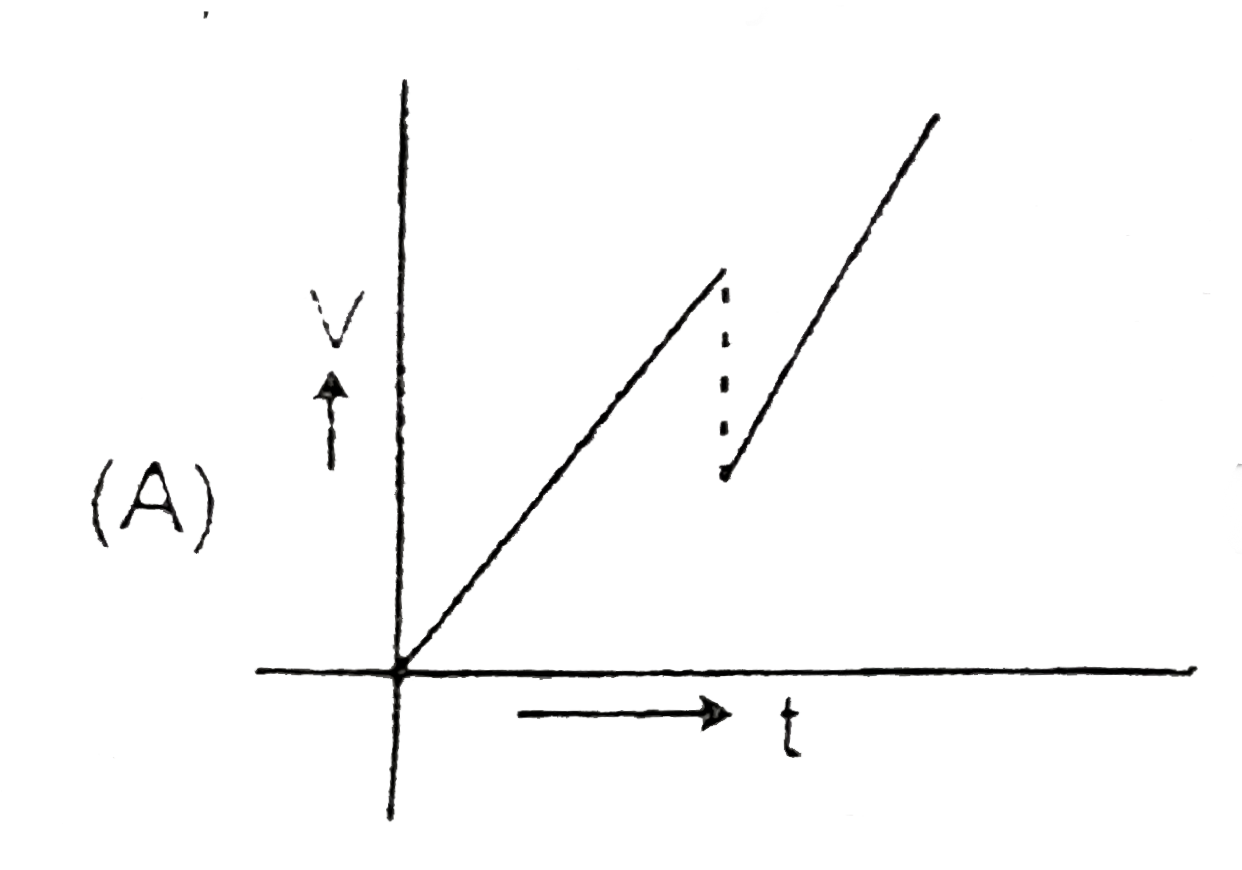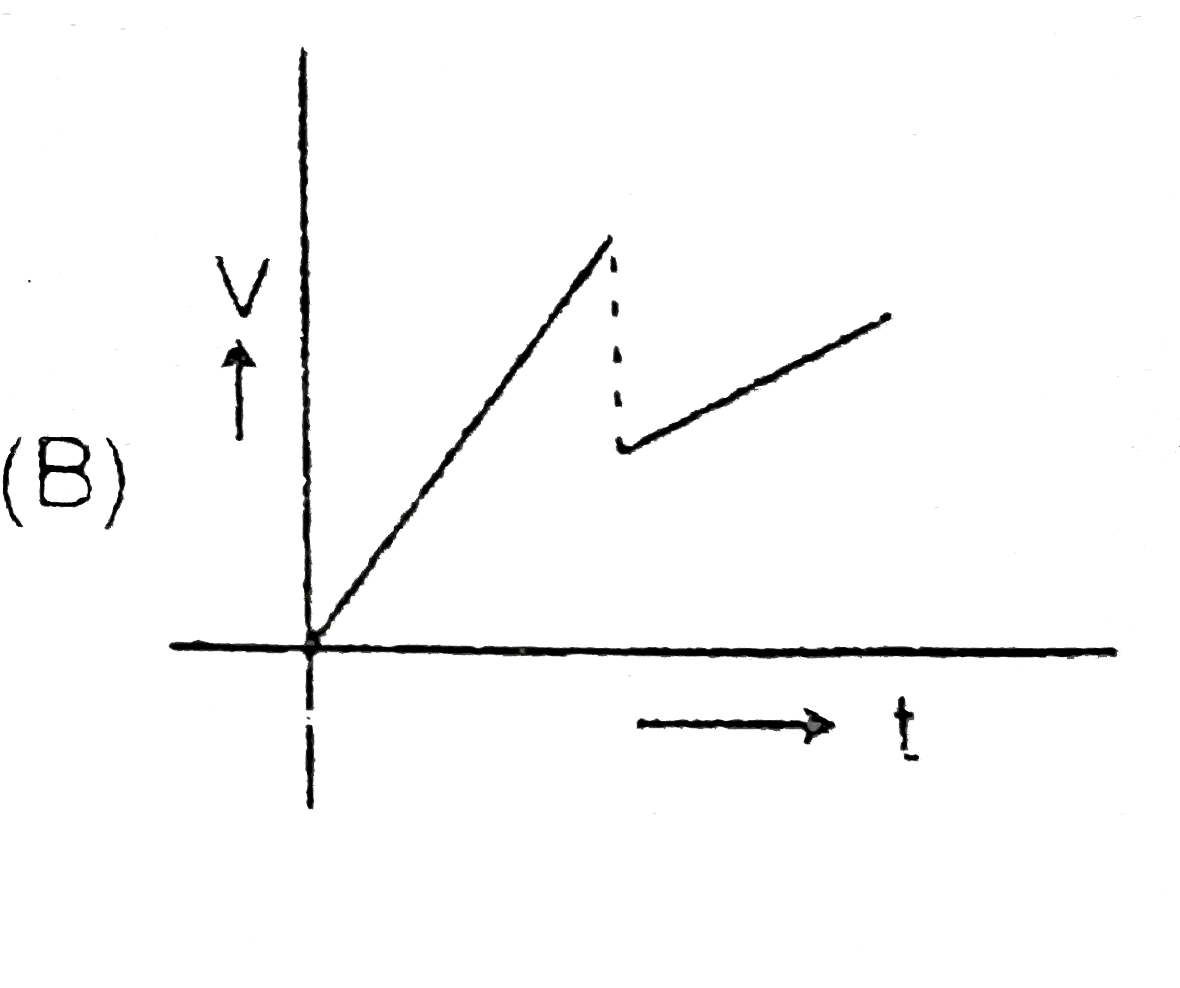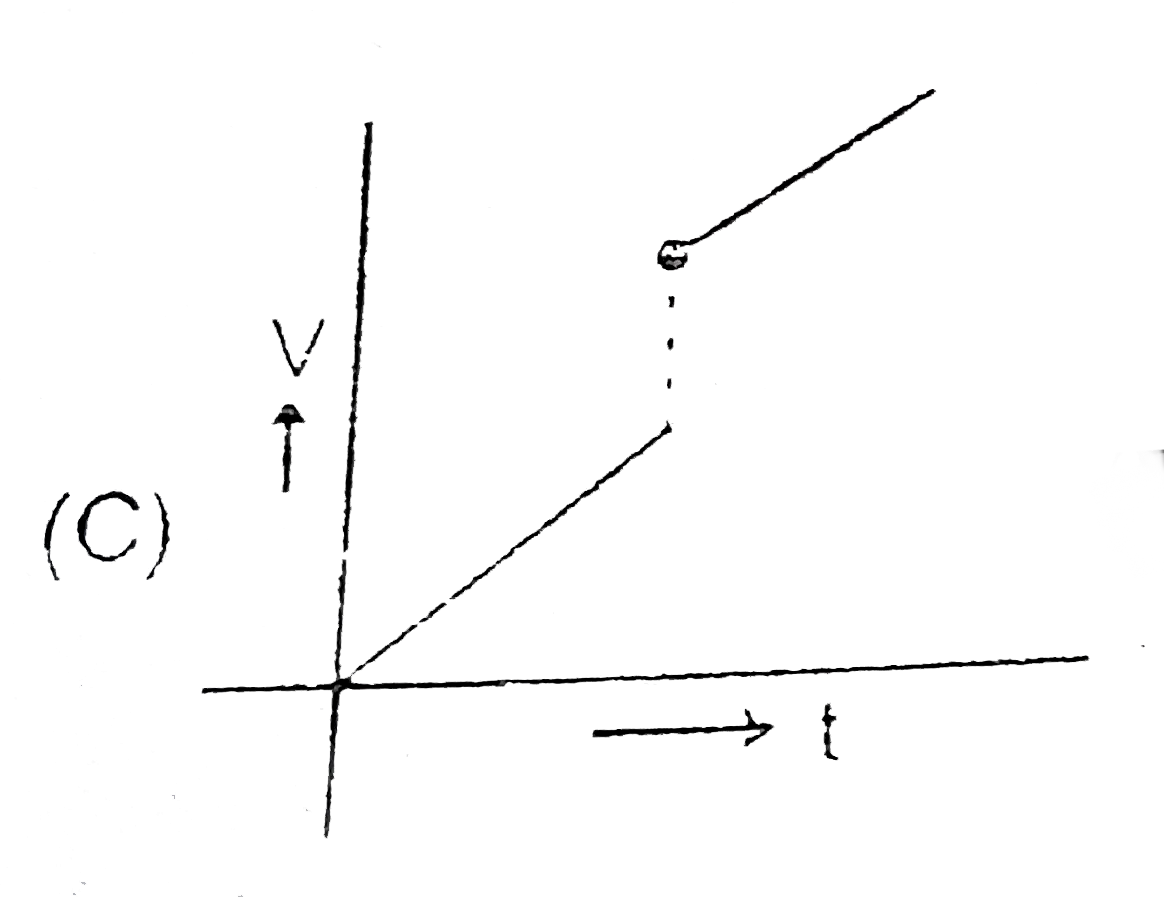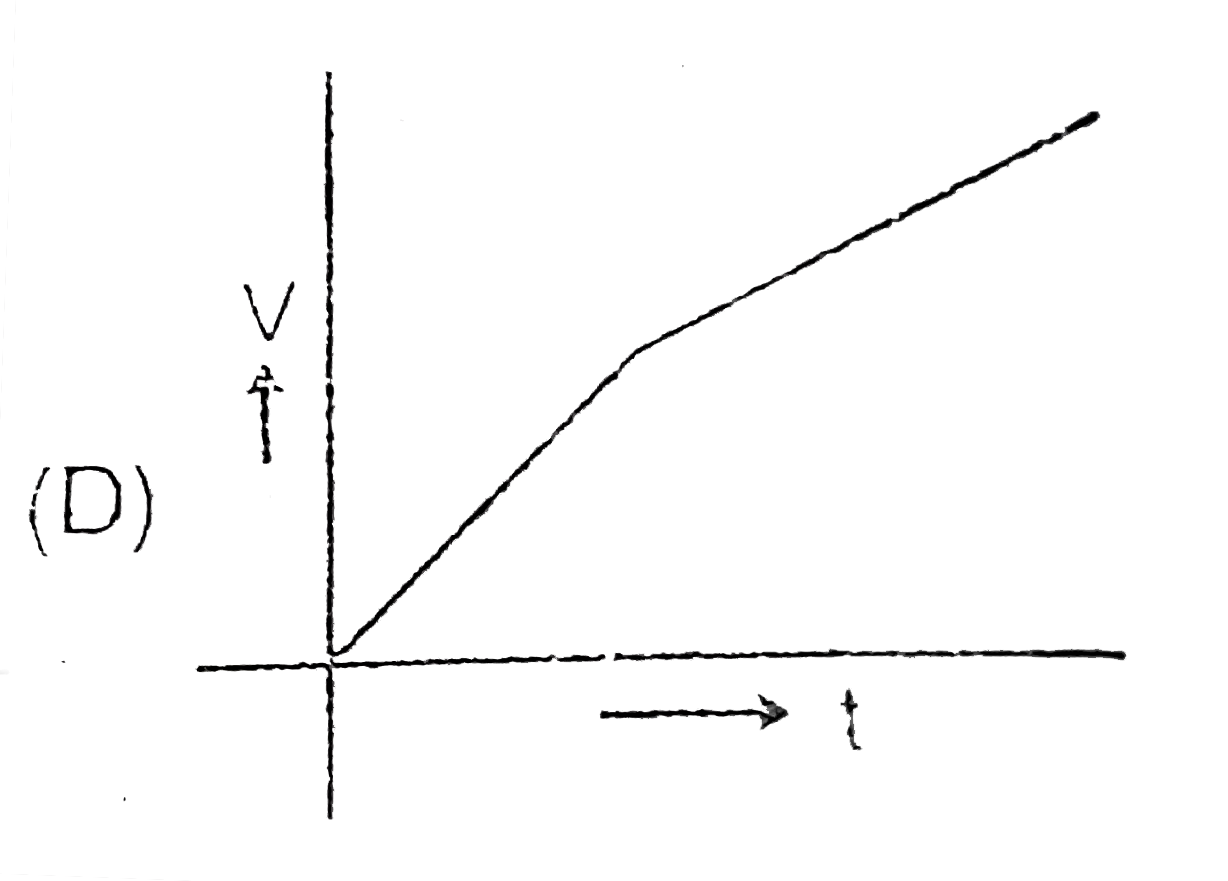Two balls of same mass are released simultaneously from heights h & 2h from the ground level. The balls collide with the floor & stick to it. Then the velocity-time graph of centre of mass of the two balls is best represented by :




The correct Answer is:B
To solve the problem, we need to analyze the motion of the two balls and how their velocities affect the center of mass (CM) of the system.
1. Understanding the Initial Conditions:
- We have two balls of the same mass (let's denote the mass as m).
- One ball is released from height h and the other from height 2h.
- Both balls are released simultaneously.
2. Calculating the Time of Fall:
- For the ball falling from height h:
h=12gt21⟹t1=√2hg
- For the ball falling from height 2h:
2h=12gt22⟹t2=√4hg=2√hg
3. Velocity of Each Ball Just Before Collision:
- The velocity of the ball falling from height h just before it hits the ground:
v1=gt1=g√2hg=√2gh
- The velocity of the ball falling from height 2h just before it hits the ground:
v2=gt2=g(2√hg)=2√gh
4. Velocity of Center of Mass Before Collision:
- The velocity of the center of mass (CM) before the collision can be calculated using:
VCM=mv1+mv2m+m=v1+v22=√2gh+2√gh2=(1+√2)√gh2
5. Collision with the Ground:
- When the first ball (from height h) hits the ground at time t1, it sticks to the ground, and its velocity becomes 0.
- The second ball continues to fall and hits the ground at time t2.
6. Velocity of Center of Mass After Collision:
- After the first ball sticks to the ground, the velocity of the center of mass becomes:
VCM=m⋅0+m⋅2√gh2m=2√gh2=√gh
7. Behavior of the Center of Mass After Collision:
- After the second ball hits the ground, both balls are at rest, so the velocity of the center of mass becomes 0.
8. Constructing the Velocity-Time Graph:
- From t=0 to t=t1, the velocity of the center of mass increases linearly.
- At t1, the velocity drops to √gh and remains constant until t2.
- After t2, the velocity drops to 0 as both balls are at rest.
Conclusion:
The velocity-time graph of the center of mass will show a linear increase until t1, a constant value until t2, and then a drop to 0. The graph that best represents this behavior is option B.
- We have two balls of the same mass (let's denote the mass as m).
- One ball is released from height h and the other from height 2h.
- Both balls are released simultaneously.
- For the ball falling from height h:
h=12gt21⟹t1=√2hg
- For the ball falling from height 2h:
2h=12gt22⟹t2=√4hg=2√hg
- The velocity of the ball falling from height h just before it hits the ground:
v1=gt1=g√2hg=√2gh
- The velocity of the ball falling from height 2h just before it hits the ground:
v2=gt2=g(2√hg)=2√gh
- The velocity of the center of mass (CM) before the collision can be calculated using:
VCM=mv1+mv2m+m=v1+v22=√2gh+2√gh2=(1+√2)√gh2
- When the first ball (from height h) hits the ground at time t1, it sticks to the ground, and its velocity becomes 0.
- The second ball continues to fall and hits the ground at time t2.
- After the first ball sticks to the ground, the velocity of the center of mass becomes:
VCM=m⋅0+m⋅2√gh2m=2√gh2=√gh
- After the second ball hits the ground, both balls are at rest, so the velocity of the center of mass becomes 0.
- From t=0 to t=t1, the velocity of the center of mass increases linearly.
- At t1, the velocity drops to √gh and remains constant until t2.
- After t2, the velocity drops to 0 as both balls are at rest.
The velocity-time graph of the center of mass will show a linear increase until t1, a constant value until t2, and then a drop to 0. The graph that best represents this behavior is option B.
Topper's Solved these Questions
- BOOK - RESONANCECHAPTER - DAILY PRACTICE PROBLEMEXERCISE - DPP No.599videos
DAILY PRACTICE PROBLEM
- BOOK - RESONANCECHAPTER - DAILY PRACTICE PROBLEMEXERCISE - DPP No.609videos
DAILY PRACTICE PROBLEM
- BOOK - RESONANCECHAPTER - DAILY PRACTICE PROBLEMEXERCISE - DPP No.579videos
DAILY PRACTICE PROBLEM
- BOOK - RESONANCECHAPTER - CURRENT ELECTRICITYEXERCISE - High Level Problems (HIP)21videos
CURRENT ELECTRICITY
- BOOK - RESONANCECHAPTER - ELECTRO MAGNETIC WAVESEXERCISE - Exercise 327videos
ELECTRO MAGNETIC WAVES
Similar Questions
Two balls of equal mass are projected from a tower simultaneously with equal speeds. One at angle θ above the horizontal and the other at the same angle θ below the horizontal. The path of the center of mass of the two balls is
View SolutionA ball is thrown upwards with a speed u from a height h above the ground.The time taken by the ball to hit the ground is
View Solution
Knowledge Check
- Question 1 - Select One
Two balls are thrown simultaneously in air. The acceleration of the centre of mass of the two balls while in air
Ais equal to g (Acceleration due to gravity)Bdepends on the masses of the two ballsCdepends on the direction of motion of the two balls.Ddepends on the speeds of the two balls. - Question 2 - Select One
Two balls are thrown simultaneously in air. The acceleration of the centre of mass of the two balls while in air
Adepends on the direction of the motion of the ballsBdepends on the masses of the two ballsCdepends on the speeds of the two ballsDis equla to g - Question 3 - Select One
Two balls of equal size are dropped from the same height from the roof of a building . One ball has twice the mass of the other. When the balls the ground, how do the kinetic energies of the two balls compare ?
AThe lighter one has one fourt has much kinetic energy as the other does.BThe lighter one has one half as much kinetic energy as the other does.CThe lighter one has the same kinetic energy as the other does.DThe lighter one has twice as much kinetic energy as the other does.
A tennis ball is released from height h above ground level. If the ball makes inelastic collision with the ground, to what height will it rise after third collision
View SolutionA tennis ball is released from height h above ground level. If the ball makes inelastic collision with the ground, to what height will it rise after third collision
View SolutionA ball is dropped from some height. After rebound from the floor it ascends to the same height. Draw the velocity-time graph for the given motion.
View SolutionTwo balls are dropped from heights h and 2h respectively. The ratio of time taken by these balls to reach the earth is
View SolutionTwo balls are dropped from heights h and 2h respectively from the earth surface. The ratio of time of these balls to reach the earth is.
View Solution

